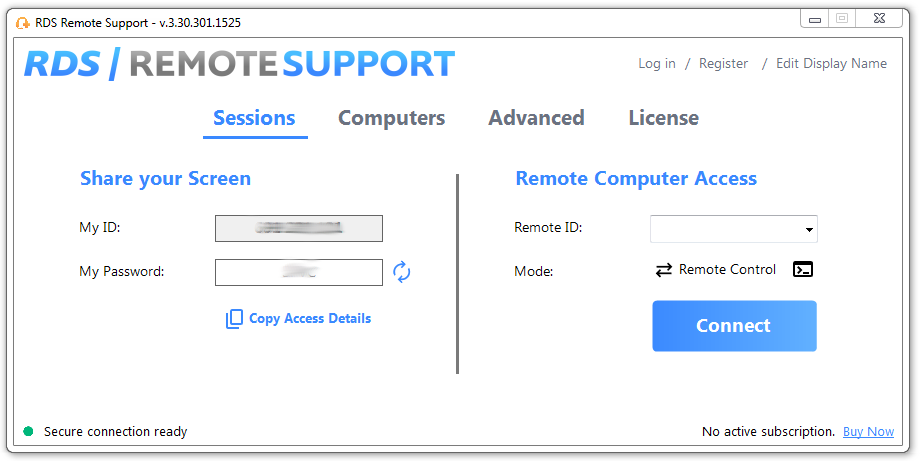"VDI vs RDP: A Practical Decision Framework (Costs, Risks & How To Supercharge RDS With or Without VDI)"
VDI vs RDP,: a practical decision making framework to examine costs, risks & requirements. Discover how to supercharge RDS with or without VDI.
Would you like to see the site in a different language?
RDS TOOLS BLOG
Accessing and managing computers remotely is not just convenient, it is essential for small and medium enterprises (SMEs) as they face unique challenges in managing their IT resources efficiently while supporting a mobile workforce and controlling costs. Remote desktop control offers a powerful solution, enabling SMEs to manage and access computers from remote locations seamlessly. This capability not only supports flexible work arrangements but also ensures the continuity of business operations, even during unforeseen disruptions.
This guide is designed for SME owners and IT managers to naviguate through the pre-RD setup process so your question "how to enable remote desktop control" should hold no secrets once we finish. We focus here on the use of built-in solutions suitable for SME and start-up budgets and technical capabilities. Explore with us both native and third-party tools, detailing their practical applications within SME environments and the added benefits of using RDS-Tools Remote Support to enter the realm of seamless remote control with functionality and security.
)
Remote desktop control involves accessing and controlling one computer from another remote location. This is facilitated through software which transmits the keyboard inputs, mouse clicks and screen images between the remote computer and the host machine. It's an essential tool for IT professionals and businesses managing networked computers, providing remote support or administering servers without being physically present.
The technology behind remote desktop services primarily revolves around the Remote Desktop Protocol (RDP). Developed by Microsoft, RDP allows a user to connect to another computer over a network connection with full graphical display capabilities. Other common protocols include VNC (Virtual Network Computing) and SSH (Secure Shell) for Unix-based systems, each serving similar purposes with varying features and security frameworks.
Remote desktop control is widely used in various scenarios, including:
The use of remote desktop control enhances productivity, reduces travel time and costs, and expedites troubleshooting and management tasks, making it an indispensable tool in modern IT infrastructures.
Workaround for Setting up Remote Desktop Access on Windows 11 Home
Of course, when starting up a business, entrepreneurs do their utmost to invest in the best possible tools for the budget they can put on the line. In an ideal world, who wouldn’t choose to only have a sturdy and powerful servers all kitted out with Windows Pro or Enterprise when beginning their route as an MSP or IT support engineer. Yet you might end up having to make do, even just due to the technical failure of better kit, with the simpler Windows Home edition and its lack of RDP. What then?
Setting up remote desktop access on Windows 11 Home requires a bit of ingenuity, as this version of Windows does not natively support Remote Desktop Protocol (RDP) functionalities found in the Professional or Enterprise editions. However, this limitation can be overcome by utilizing third-party software, such as Thinstuff RDH (Remote Desktop Host), which enables RDP capabilities on Windows Home editions.
By following these steps, you can enable remote desktop functionality on a Windows 11 Home system, overcoming the default limitations of the operating system.
Enabling Remote Desktop Access on Windows Pro
For users with Windows Pro, setting up remote desktop access involves leveraging the built-in Remote Desktop features included with these versions. The process emphasizes not just basic setup but also advanced configurations which enhance performance, security and manageability.
RDS Remote Support is an affordable, secure and easy-to-use solution for remote desktop control. In many ways, this tool simplifies IT management, allowing remote troubleshooting, unattended maintenance and secure data handling across Windows, Android and macOS platforms.
Key Features:
RDS Remote Support is designed for efficiency and scalability, supporting unlimited users and devices. It is consequently an ideal choice for SMEs looking to reduce IT costs and improve operational workflows without compromising security or functionality.
For SMEs aiming to enhance their IT capabilities, RDS Remote Support offers a comprehensive solution combining reliability, security and ease of use at a competitive price. Start with a free 15-day trial to see how it can streamline your remote desktop operations.

RDS Remote Support Free Trial
Cost-effective Attended and Unattended Remote Assistance from/to macOS and Windows PCs.
RDS-Tools provides a suite of enhancements which significantly improve the functionality, manageability and security of IT infrastructures, particularly in environments using remote desktop services. These tools are designed to integrate seamlessly with existing IT setups, extending their capabilities and offering a more streamlined, secure and efficient management experience.
These enhancements not only make it easier for IT departments to manage remote environments but also provide a safer and more productive experience for end-users.
Enabling remote desktop control is crucial for businesses looking to maintain efficiency and continuity for any business, especially SMEs. Through this article, we've explored how to set up remote desktop access on both Windows 11 Home using third-party software and Windows Pro with its built-in functionalities. Additionally, we discussed how RDS-Tools can enhance these infrastructures by improving security, manageability, and performance.
Whether yous is a small or growing business looking to access your home computer from afar or a larger enterprise with broader needs, these tools and techniques will help you establish a robust remote desktop environment. Explore RDS-Tools further to discover how they can transform your remote access capabilities and elevate your IT infrastructure.
We encourage you to visit our product pages to learn more about RDS-Tools and to reach out to our support team for personalized advice and demonstrations.
Simple, Robust and Affordable Remote Access Solutions for IT professionals.
The Ultimate Toolbox to better Serve your Microsoft RDS Clients.
 Get in touch
Get in touch
